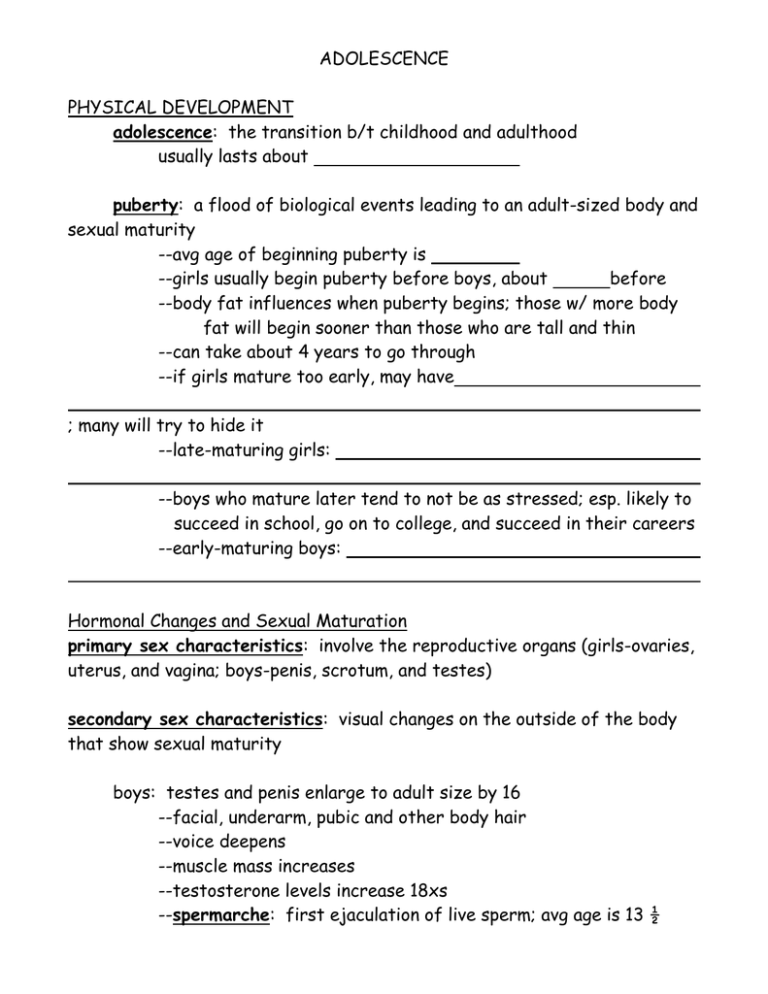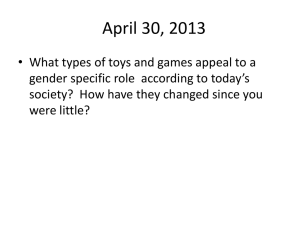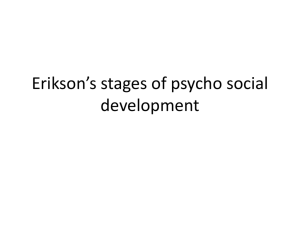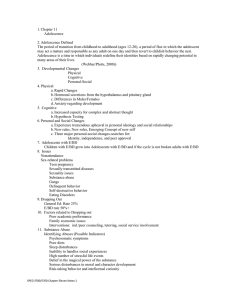
ADOLESCENCE
PHYSICAL DEVELOPMENT
adolescence: the transition b/t childhood and adulthood
usually lasts about
puberty: a flood of biological events leading to an adult-sized body and
sexual maturity
--avg age of beginning puberty is
--girls usually begin puberty before boys, about
before
--body fat influences when puberty begins; those w/ more body
fat will begin sooner than those who are tall and thin
--can take about 4 years to go through
--if girls mature too early, may have
; many will try to hide it
--late-maturing girls:
--boys who mature later tend to not be as stressed; esp. likely to
succeed in school, go on to college, and succeed in their careers
--early-maturing boys:
Hormonal Changes and Sexual Maturation
primary sex characteristics: involve the reproductive organs (girls-ovaries,
uterus, and vagina; boys-penis, scrotum, and testes)
secondary sex characteristics: visual changes on the outside of the body
that show sexual maturity
boys: testes and penis enlarge to adult size by 16
--facial, underarm, pubic and other body hair
--voice deepens
--muscle mass increases
--testosterone levels increase 18xs
--spermarche: first ejaculation of live sperm; avg age is 13 ½
girls: breasts develop (fully developed avg 14)
--body fat
increases to prepare for pregnancy
--underarm and pubic hair
--estrogen levels increase 8xs
--menarche: beginning of menstrual cycle (avg. age is 12)
some girls will have a menstrual cycle without an ovum being
released for 12-18 mos. after first menstrual cycle; not always
Body Growth
growth spurt: rapid gain in height and weight
--girls begin around 10 and boys around 12
--become all legs and arms, and feet
--at the beginning of adolescence, girls are taller and heavier but not
by 14
--girls reach adult body size about
, boys about
--add 10-11 inches in height and 50-75 lbs during adolescence
HEALTH ISSUES
Sexual Activity
sexually transmitted infection (STI): an infection spread by sexual
contact
sexually active teens have higher rates of STIs like
1:6 contracts one of these diseases a year
younger people are less likely to use protection and are less likely to
report having an STD
AIDS is also a problem, with 1/5 of the U.S. cases being young people
b/t the ages of 20 and 29; because of the amt of time it takes for the virus
to emerge, most cases began in adolescence
Pregnancy:
about 900,000 teenage girls become pregnant in the US every year;
30,000 of them are younger than 15
1:5 births to adolescents are repeat births
girls who have sex within a year or two after menarche are more likely
to suffer from many complications of pregnancy and birth, including
this is all because her body is not fully mature yet
can expect these complications more if she is under 16
early pregnancy affects the likelihood of girl finishing high school;
reduces academic achievement by about 3 years
teen mothers also are less likely
Substance Use and Abuse
by 10th grade,
of young people have tried cigarettes,
and
at least one illegal drug (mainly marijuana)
drinking,
by the end of high school,
smoke cigarettes regularly,
can
be considered heavy drinkers and
have experimented with
illegal drugs
those who smoke tend to be
waited until fully grown
than if they had
many adolescents who drink or smoke are just experimenting, possibly b/c
their friends are doing it; some also do it to cope with stress
a small percentage of adolescents will eventually abuse the drugs, so will
become physically and psychologically addicted to the drugs
COGNITIVE DVLPT
reasoning is expanding and understanding is no longer concrete as in
concrete operational stage
begin to think hypothetically
hypothetical thought: thought and reasoning that includes problem solving
that may not include reality
so able to think in an abstract and scientific way
EX: “If dogs are bigger than elephants, and elephants are bigger than mice,
then dogs are bigger than mice.”
since this is hypothetical, a child would automatically say that
elephants are bigger than dogs b/c their thinking is concrete
unfortunately some individuals don’t reach the formal operational stage
where they use hypothetical thought
one reason is b/c they tend to stick with
also the thinking is limited to situations in which they have
so if the opportunity is not there, hypothetical thought is not
developed
adolescents also begin to develop a new form of egocentrism where they
have difficulty distinguishing their own and other people’s perspectives; they
concentrate on themselves a lot more
imaginary audience: they believe they are the focus of everyone’s attention
and everyone is concerned with them
become extremely self-conscious and do just about anything to avoid
embarrassment
EX:
personal fable: think they’re unique, special, and invincible
no one can possibly understand what they are going thru b/c their
situation is different
EX:
Learning in School and Academic Achievement
are transitioning into middle school or junior high school
stressful for many of them coming from elementary where not much is
expected of them, not a lot of changing classrooms and many different
teachers to just about being on their own in school
grades tend to decline, don’t get personal attention as before, view
teachers to be less friendly and don’t grade fairly
Those that have high academic achievement:
authoritative parenting with parents being more involved in their
education, parents also allow them to make more decisions
peers are supportive of high achievement
school characteristics: teachers are warm and supportive, interact
with parents; are encouraged and challenged to think on a higher level
Drop outs:
approx
of young Americans don’t get their high school
diploma
many of those may become employed but usually
factors:
PSYCHOSOCIAL DVLPT
The Self and Identity
identity: how you consistently define yourself
adolescents experiment with different ways to define themselves,
trying to not depend entirely upon their characteristics they defined in
themselves as a child
they keep some of these characteristics, but add others to eventually
define who they are; includes different
Change in self-concept:
begin to identify themselves based on how they are in different
situations so at times may seem conflicting; different with
also begin to emphasize more social virtues like being friendly,
considerate, kind, and cooperative
Change in self-esteem:
self-esteem usually declines during
but
typically rises after that; begin to feel good about their achievements and
their friendships
false self: acting differently from how they really are; may do it to
may feel that their real self will be rejected b/c no one likes it
may try to please parents or conform to how friends are
may want to see what it would be like to be different
gender identity: how society defines male or female roles and behavior
Problems with Development
Depression:
--feel sad, frustrated, hopeless about life, lose pleasure in normal
activities, disturbed sleep, appetite, concentration, and energy
--most common psychological problem of adolescence
-of teens have had one or more major depressive
episode
-suffer from chronic depression (a few months to yrs)
--girls
than boys
--heredity and traumatic events are factors (failing at something,
parental divorce, end of close friendship or romantic relationship)
Suicide:
--rates increase sharply during adolescence
-leading cause of death among young Americans
--boys outnumber girls by
--factors:
--gay, lesbian, and bisexual adolescents are more likely to attempt
suicide,
more likely than other adolescents; possibly b/c of conflict
within family and inner turmoil and peer rejection
Delinquency and Rebellion:
--about 17% of arrests in U.S. are adolescents
--most are minor offenses like disorderly conduct and petty theft
--many don’t commit to a life of crime
Family and Friends
Relationship with parents:
generation gap: the distance b/t generations in values, behaviors, and
knowledge, marked by a mutual lack of understanding
conflict is higher in
and begins to
decrease by 17 or 18, possibly b/c in early adolescence, their identity isn’t
fully formed and may go through identity confusion; by 17 or 18, identity is
formed and can even somewhat identify with parents in certain ways
Friends and Dating:
--friends are extremely important, esp when forming identity
--look more for
from friends, same
--girls have more
, so “just
talk” and self-disclose, where they share innermost thoughts and feelings
--boys are more
—sports or competitive games
--in early adolescence, dating relationships don’t last long, but by 16
the relationships can last for on average
--look for
--typically are over by the time they are out of high school b/c realize
their differences b/c identity is just about complete









